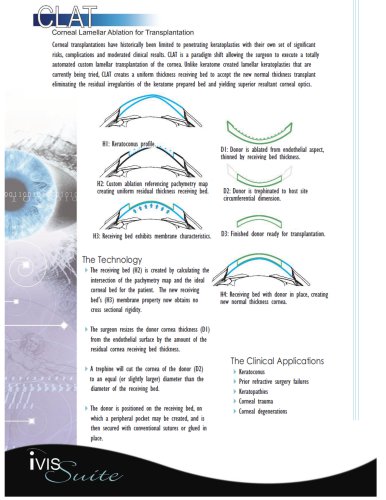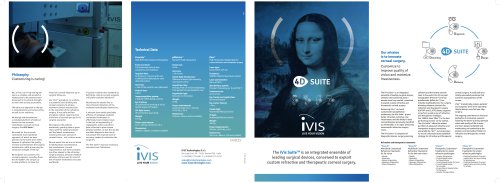
Catalog excerpts

Built upon a strong basis of physiological optics while respecting corneal physiology, CIPTA has demonstrated excellent clinical results in delivering custom refractive surgery to primary through complex secondary cases. CIPTA is a fundamental departure from refractive-only approaches marketed with wavefront treatments. Surgery is executed on the surface that is mapped in high definition. This sharply contrasts to etching a lens /aberration map on a surface thusly altering shape, but without regard or knowledge of its shape. Strong science, excellent results. The Technology CIPTA's unique patented process incorporates the following core concepts: The volume of the ablation (1) is defined by the intersection of the existing, detected anterior surface of the cornea and the ideal corneal surface. The ablation takes into account the patient's real anterior corneal surface and it is not derived from a mathematical calculation based upon a lens application. (2) The intersection of the measured surface and the ideal aconic surface (3) must be as large as the IDEAL PUPIL seen projected at the anterior surface of the cornea. The optimum ablation dimension minimizes the volume of tissue to be ablated, while assuring that this refractive area completely covers the IDEAL PUPIL. The variable width transition zone (4) guarantees a constant slope in all radial directions, with linear variation of the curvature. This constant slope physiologically moderates the risk of regression. The center of the ablation is determined automatically, with the surgeon defining the reference axis of the ideal aconic surface, which by default is the Morphological axis. This can have significant impact on tissue sparing and is a CIPTA exclusive feature. cTEN, our proprietary custom transepithelial no-touch strategy, may be selected by the surgeon to eliminate additional keratome induced aberrations that are unmeasured and unaccounted for with LASIK. CIPTA or Wavefront? Wavefront, standard and placido topographic ablations attempt to directly compensate for the refractive error of the eye under the assumption that there is no need to know corneal morphology. CIPTA states that the refractive process is the natural consequence of the morphology of the surfaces. The refractive process is generated by the morphology of the surface and not vis-a-versa! Wavefront, standard and placido topographic ablations apply a lens to the cornea to compensate for the refractive error. CIPTA, to optimize the quality of vision for the patient, regularizes the anterior surface of the cornea by means of the identification and location of the ideal shape. The refractive correction is the natural consequence of the corneal regularization
Open the catalog to page 1
iVIS Technologies S.r.l. Via Luigi Corsi, 50 | 74121 Taranto (TA) - Italy T: +39 (099) 779-1680 | F: +39 (099) 779-7270 sales@ivistechnologies.com | www.ivistechnologies.com
Open the catalog to page 2All IVis Technologies catalogs and technical brochures
-
CLAT®
2 Pages
-
The 4Ds of ideal vision
2 Pages



